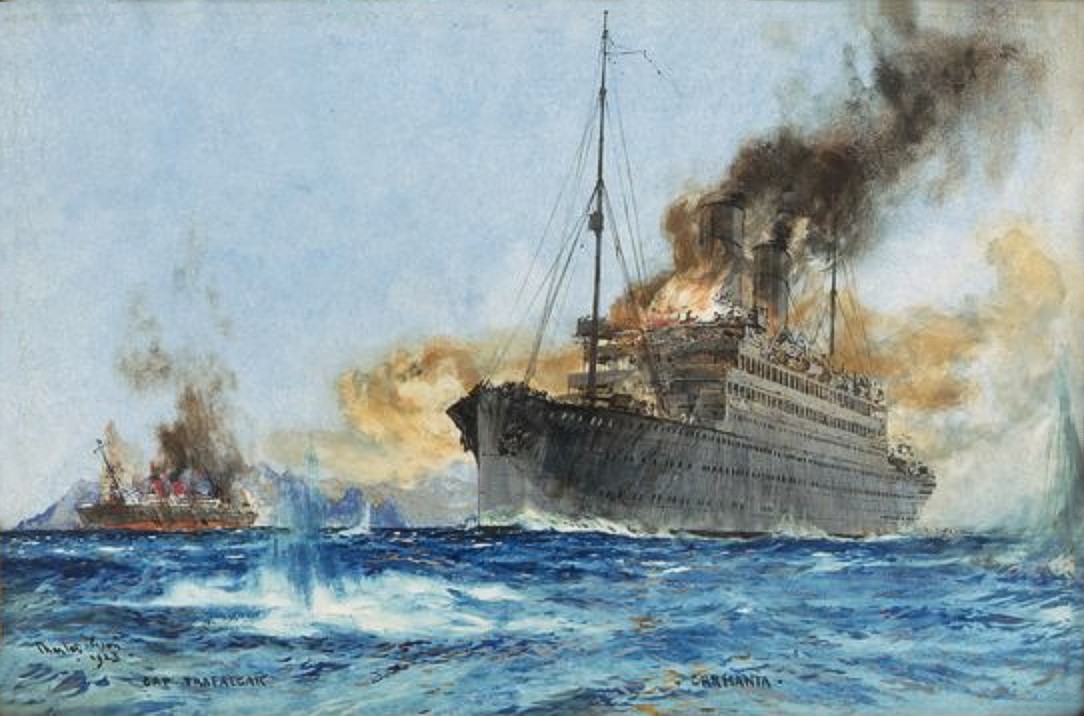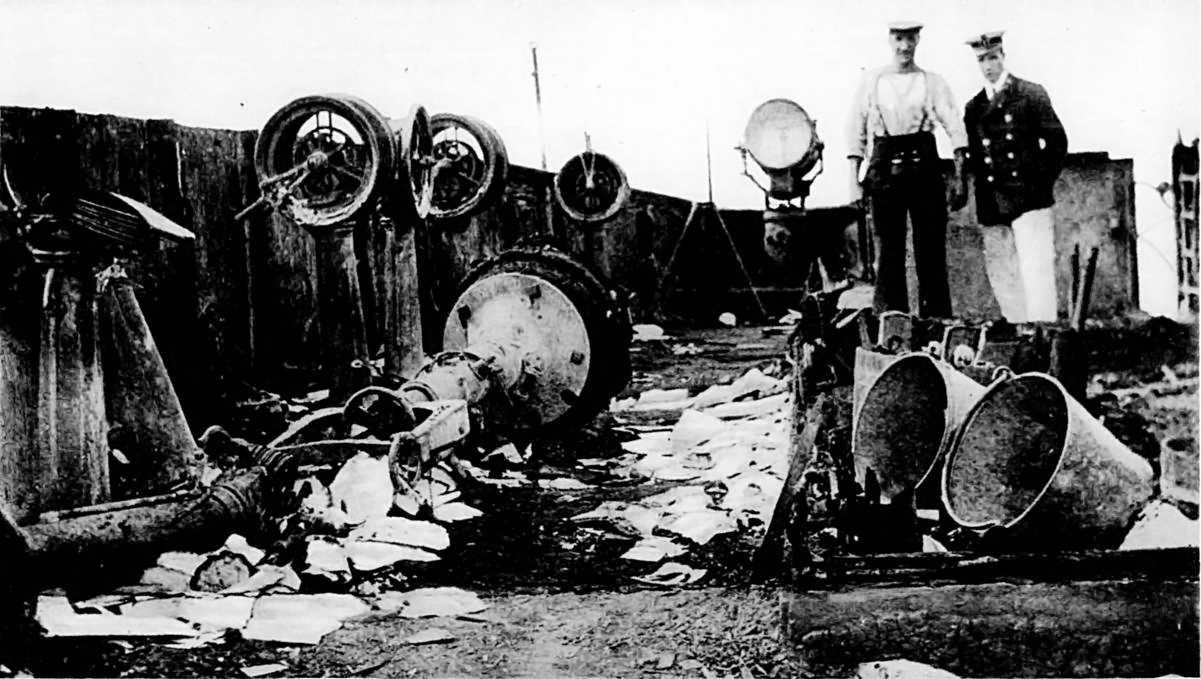- Yes
- No

The HMS Carmania during World War I in dazzle camouflage. Nova Scotia, 1918.
Note: This is an old suggestion imported from the old WT forum.
It was 3 years ago that I suggested the HMS Carmania, one of the several bizarre “armed merchant cruiser” ship of World War I that ignited my interest on weird & wacky vehicles, so I would like to re-suggest this thing again before the old forum’s closure.
Key Characteristics
- One of the several ocean liner-turned “armored merchant cruiser” of WWI with a peculiar history of sinking her imposter.
- Armed with eight 6-inch Mk. VII guns with decent firepower, but completely lacking in secondaries and AA.
- Compared to the other similar ship, she’s not quite remarkable aside from her history, but still a funny addition.
History
Spoiler
The RMS Carmania was the second of the Caronia-class ocean liner built for the Cunard Line. She was laid down on 17 May 1904 and launched on 21 February 1905. While built to mostly the same specifications, Carmania was outfitted with the more efficient three propeller steam turbine engines compared to two screw-propelled quadruple-expansion engine of her sister ship. This was intentionally done to test the better propulsion for the future Lusitania-class liners. At the time of her completion, RMS Carmania became the fastest and largest ship of the Cunard Line.
Model of the RMS Carmania in her 1905 configuration.
On 2 December 1905, RMS Carmania left Liverpool for her maiden voyage to New York. For five years between 1905 to 1910, she served between Liverpool and New York. In June 1910, she caught fire in her passenger accomodation, though the ship does not suffer any structual damage. On October 1913, Carmania was involved in a rescue operation of an ocean liner Volturno, which resulted in many awards being granted to her crew, including her Captain James Clayton Barr.
Scheme of the RMS Carmania in 1911, showing the engines layout.
At the outbreak of the Great War on August 1914, RMS Carmania was underway from her return trip across the Atlantic. After made her way back to Liverpool on 7 August, Carmania and her sister Canoria was quickly put into conversion into an armed merchant cruiser (AMC), as per naval doctrine at that time that both the British and German navy utilized existing commercial vessels as a combatant to quickly fill their ranks at the early stage of the war. After being outfitted with eight 4.7-inch (120 mm) Mk. V guns in single mount distributed on her deck’s bow and stern, she was commanded by the Captain 1st rank Noel Grant, while peacetime captain James Barr were appointed as his assistant.
A rangefinder on the HMS Carmania, 1914.
Shortly after conversion and her redesignation as HMS Carmania (M 55), the ship was sent to the Bermuda, where she arrived on 23 August. There, she was sent to hunt the German colliers off the coast of Brazil, of which her speed of 18 knots (33.3 km/h) and her heavy armament is more than enough to dispese them.
On 14 September 1914, after sailing to Pernambuco and near the Trindade island, HMS Carmania encounted what appears to be a large twin-stack liner with the paint scheme of the British Union Castle shipping company loading coals from two colliers on the bay of the island. After that mysterious ship spotted the Carmania, she quickly steamed away from the Carmania.
Upon noticing the ship in friendly colors trying to get away from the ship, Captain Noel quickly realized that it was actually a German AMC disguised as a British ship. He then ordered the Carmania to chase them and closing in to the adversary.
The SMS Cap Trafalgar and a collier SMS Eber docking in the bay of the Trindade island, shortly before her fateful battle with the Carmania.
The ship turned out to be the SMS Cap Trafalgar, a German ocean liner belong to the Hamburg - Amerika Line that were pressed into the service as AMC a few months prior. In a twists of irony, the Cap Trafalgar were modified by her crew to disguise her as the Carmania. And now, Cap Trafalgar - the imposter ship - is going to face-off against the actual Carmania.
At 12:10, the Carmania fired a warning close to the starboard of the Cap Trafalgar, which prompted the latter to fire back, thus commence the “world’s first battle of the ocean liners”.
One of the 4.7-inch (120 mm) guns on board the HMS Carmania.
While both ship is similar in size and speed, the Carmania has an edge over the Cap Trafalgar due to her superior firepower (the German ship were only armed with two 105 mm guns and six Hotchkiss rotary autocannons), however the German ship is mostly crewed by a proper military sailor as opposed to the British liner which her crew were mostly mixed between civilians and military sailors. As such, while the Cap Trafalgar suffers heavy fire damage, she also manages to score a hit on the Carmania’s bridge owning to better gunnery, causing fire that quickly engulfed the upper deck, forcing Captain Noel abandon the fore bridge. Due to the ship’s fire prevention system were also being hit, the ship lacked any water to dose the flame and continued the fight while being ablaze.
“The Battle of Trindade”, a painting by Charles Dixon.
As the ships were getting too close, the captains of both ships decided to steaming away from each other to make rooms for their engagements. Alternating between the bow and stern firing position, the Carmenia delivered numerous critical hits to the German doppelganger. At 13:50, roughly 1 hour and 40 minutes after the first shot, the SMS Cap Trafalgar capsized on her starboard side, then sunk bow first. Around 50 German sailors were killed, while the British lost totalled 9 men. The rest of the 279 German survivors were later rescued by the collier SMS Eber.
As the crew of the Carmenia were busy fighting flames, they spotted a smoke of what appears to be a cruiser. Thus the ship was ordered to retreat back to Gibraltar for her repair. It turned out that the ship in question was in fact the SS Kronprinz Wilhelm, another German ocean liner-based ACW that picked up the SOS signal of the Cap Trafalgar moments ago. However, rather than engaging with the stricken British liner, the Wilhelm choose to spare the ship due to fear that it was a trap of the Royal Navy to lure his ship into the range of British cruiser, partly due to confusion between the signals sent from both ship during the engaments, not helped by the fact that the Cap Trafalgar was posing as the British liner before her sinking.
As this is the first battle involving armed merchant cruiser, many lessons were learned from this encounter. The post-battle assessment deemed that an armed merchant cruiser can prove useful against other ships, but is much more vulnerable to delicated anti-ship weaponry than a delicated warship.
The aftermath of the Battle of Trindade; the burned deck of the HMS Carmenia, 1914.
Temporary bridge of the HMS Carmenia, 1915.
After sailing the crippled ship back to Gibraltar on December 1914. HMS Carmenia underwent emergency repairs until January 1915 when she sailed again. This time patrolling along the coast of the Canary islands before returned to Plymouth on June 1915 for her extensive repair and refit. There, her armaments were replaced with eight BL 6-inch (152 mm) Mk. VII guns placed in the same position as the 4-inch guns.
HMS Carmania at Merseyside, 1915. Note the smoke funnel that were painted all black during her early services in contrast with Cunard’s usual black-and-red scheme.
As the urgent need of commerce raiders has subsided and the operation cost of the AMC became more costly and inefficient, the HMS Carmenia, along with some other AMCs, were reassigned as a troop transport ship. After her involvement in the Galipoli campaign between 1915 and 1916, HMS Carmenia received her final wartime refit to add the smoke-generating device.
Painting of HMS Carmenia in 1916 refit. Her four 6-inch cannons can be seen in this image.
At the end of the war in 1918, HMS Carmenia spent her time repatriating Canadian troops home from Europe. By 1919, she was converted back into RMS Carmenia and returned to commercial services. After spending four years as a warship, the Carmenia is no longer a state-of-the-art warship and were thus refitted by the Cunard Line in 1923 as a cabin class ship for regular travels. Carmenia and her sister continued her service until 1929 when the Great Depression struck, effectively freezing the shipping industry. Finally, in 1932, the RMS Carmenia was sold for scrap at Blyth.
Specifications
Spoiler
Displacement: 9,981 tons empty load, 19,524 tons full load
Length: 198.2 meters registered, 207 meters overall
Breadth: 22 meters
Draught: 10.13 meters
Depth: 12.2 meters
Polpusion system: 1 x High-pressure steam turbine, 2 x Low-pressure steam turbines, 3 x propellers
Power: 21,000 h.p.
Top speed: 18 knots (33.3 km/h)
Armor: None, save for the gun shield
Armament: 8 x 6-inch (152 mm) BL Mk. VII guns in eight single mounts, four on the bow and stern each
Crew: 421 (Officers: 25, petty officers: 43, seamen: 131, marines: 38, engine crews: 156, stewardry: 28)
Sources
Spoiler
Simpson, Colin (1977). The Ship that Hunted Itself. Harmondsworth: Penguin Books. ISBN 0-14-004823-5.
Osborne, Richard; Spong, Harry & Grover, Tom (2007). Armed Merchant Cruisers 1878–1945. Windsor: World Warship Society. ISBN 978-0-9543310-8-5.
William Lowell Putnam. The Kaiser’s merchant ships in World War I . — 2, illustrated. - McFarland, 2001. - P. 47-49 . — 248p. — ISBN 0786409231 .
Deward Barnes, Bruce Cane. It made you think of home: the haunting journal of Deward Barnes, Canadian Expeditionary Force, 1916-1919. — illustrated. - Dundurn Press Ltd, 2004. - P. 273. - 318 p. — ISBN 1550025120 .
RMS Carmania (1905) - Wikipedia
SMS Cap Trafalgar - Wikipedia
RMS Carmania (1905) — Википедия (in Russian)
Carmania (I) – TGOL
Volturno Datapage 59 - Page 4 re S.S. CARMANIA
HMS Carmania, armed merchant cruiser - British warships of World War 1









